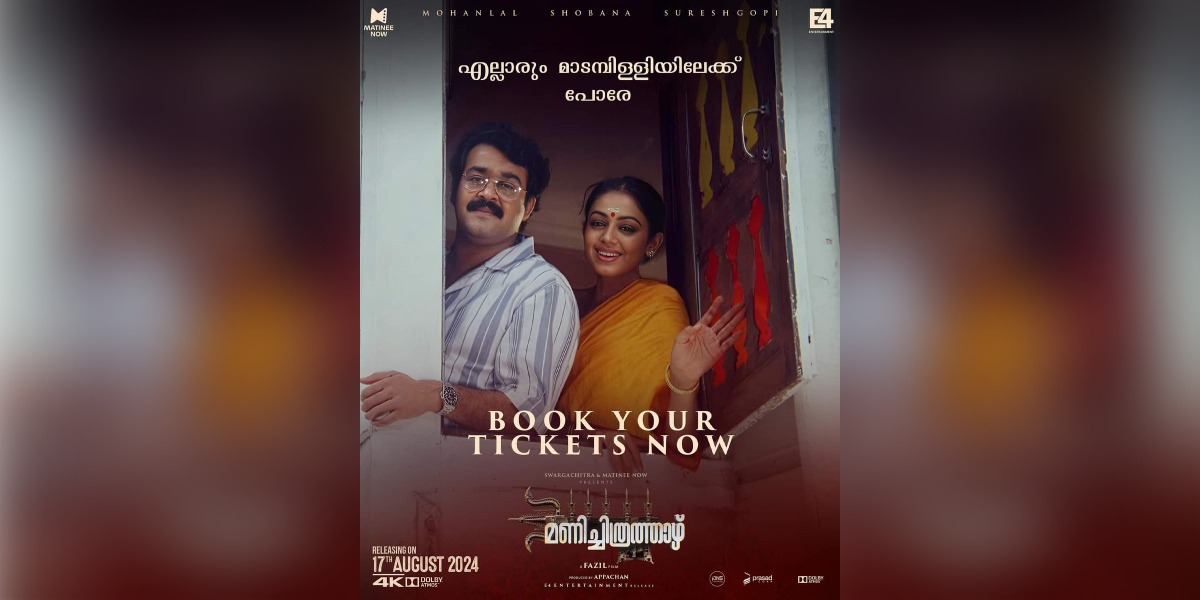Madhu Muttam's script and Fazil's direction helped the film achieve huge success in 1993. The 4K version now being screened in 106 centres.
Published Aug 17, 2024 | 11:15 AM ⚊ Updated Aug 17, 2024 | 11:15 AM

Manichitrathazhu: Malayalee audience excited about the re-release of this timeless classic. (X)
As the Malayalam movie Manichitrathazhu (1993) re-releases in theatres on Saturday, 17 August, I’d like to say, “Cinema is an emotion”. The Mohanlal and Shobana-starrer is available on 106 screens.
Nostalgia has economic value and is wisely marketed, even in show business. The re-release of old films offers a nostalgic experience to viewers in their 30s and 40s. Even the older generation loves revisiting their younger days by watching films that have high repeat value.
This trend is relatively new in Malayalam cinema compared to other languages like Tamil, Telugu, and Hindi. In Tamil Nadu, old Rajinikanth films are often re-released on his birthday. For instance, I watched the veteran actor’s Baasha in a Chennai multiplex.
The trend of re-releases in Malayalam cinema began in 2023 with Monahalal’s Spadikam (1995), which became a commercial success by earning over ₹3 crore at the box office.
Similarly, Devadoothan, which flopped when it was first released in 2000, succeeded in theatres after its re-release. The Mohanlal-starrer collected ₹5 crore after 24 years, thus bringing profits to its makers.
And now, it’s time for the re-release of Manichitrathazhu (1993). This timeless classic, which won numerous accolades upon its release 31 years ago, remains a favourite for cineastes because of its emotional depth.
It won’t be an exaggeration to say that every film-loving Malayalee would have watched the film at least 10 times.
Though new outings like Nunakuzhi and Vaazha are pulling crowds to theatres, the remastered 4K version of Manichitrathazhu is expected to do good business at the box office.
The Malayalam channel Asianet holds the satellite rights for Manichitrathazhu. The film consistently received high TRP ratings whenever it was aired, showing its enduring popularity.
In an interview, producer Swargachithra Appachan recounted that Manichitrathazhu didn’t attract many viewers on the opening day. It was only after the first-day reports that the movie gained an audience and eventually became a super hit.
The classic movie uniquely blended horror with psychological elements, offering viewers a new experience. Until then, audiences were accustomed to horror films featuring ghosts in white sarees.
Nevertheless, the film broke away from those traditional horror stories and misconceptions that glorified superstitions. Further, it gave a proper (medical) explanation to help viewers understand the dual personality disorder faced by Ganga (played by Shobana).
Madhu Muttam’s script and Fazil’s direction helped Manichitrathazhu achieve unexpected success.
Director Fazil mentioned, in an interview, that the climax was the toughest part of the film to shoot. He was initially confused about how to film the climax portion, where Shobana’s character was supposed to cut Suresh Gopi’s throat.
Suresh Gopi suggested that a wooden bench be created so he could be strapped on one side and Thampi’s dummy on the other.
The team rotated the bench using a pulley-like structure at the right moment. This climax scene took a lot of time to shoot, spanning 16 continuous nights, while the rest of the movie was smooth sailing.
Manichitrathazhu is now re-released in 4K projection with Dolby Atmos sound technology. However, restoring the movie became a huge challenge for the makers as the original print was lost.
They managed to retrieve an analogue print from the archives in Pune and began the remastering process. Matinee Now and E4 Entertainment distributed the remastered 4K version of the film.
Swargachithra Appachan recalled that Mohanlal, who played the lead character of Dr Sunny in the flick, was initially sceptical about whether the restoration would be possible since most old film prints are not properly preserved. But it’s all history and the film has been re-released on a grand scale.
#Manichitrathazhu when it first released in 1993 in 26 screens. Today in 2024, Re-Release in 106 screens!!
Business of Cinema has changed! pic.twitter.com/XPR3VD479p— Sreedhar Pillai (@sri50) August 17, 2024
Malayalam scriptwriter-director PS Arjun notes that the audience for classic movies usually consists of people who have already seen them in theatres or on TV.
“What’s driving them is nostalgia and the celebration of a film they already love. If re-released, movies like Vandanam (1989), Kilukkam (1991), and Minnaram (1994) could similarly attract audiences,” he tells South First.
The Pattaapakal (2024) director recalls that Rajinikanth’s Tamil movies were often re-released in the 2000s. “I remember watching many of his old films in theatres during those re-releases. I used to visit cinema halls simply to experience my favourite movies on the big screen after loving them on smaller screens.”
He adds, “Now, with Vijay’s Ghilli (2004) doing great business, I believe that old movies can attract a dedicated audience in Malayalam cinema as well.”
Manichitrathazhu was remade in several languages, including Hindi, Tamil, Bengali, and Kannada.
It was remade in Hindi as Bhool Bhulaiyaa (2007), starring Akshay Kumar and directed by Priyadarshan. In Tamil, it was remade as Chandramukhi (2005) with Rajinikanth under the direction of P Vasu. The Kannada version was Apthamitra (2004) and the Bengali version was titled Rajmohol (2005).
Though these remakes were superhits in their respective languages, they didn’t quite match the original.
According to a film critic, the Manichitrathazhu remakes did well because the content was strong but the performances in Tamil and Hindi can’t be compared with those in the original version.
For instance, Chandramukhi was a typical Rajinikanth movie, and the script was altered to suit his style. Additionally, Jyotika’s performance didn’t measure up to Shobana’s, the critic points out.
Similarly, the Hindi version with Vidya Balan—who is usually a good actor and dancer—was also disappointing when compared to Shobana’s performance.
However, the critic is super excited to watch the remastered version since it not only makes one nostalgic but also offers a new film-viewing experience. Well, true that!
(Edited by Y Krishna Jyothi)
